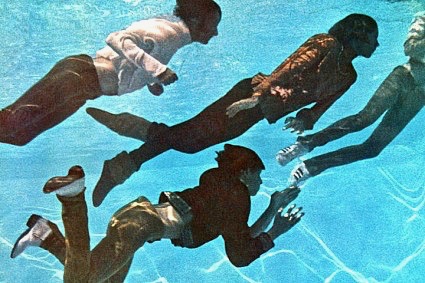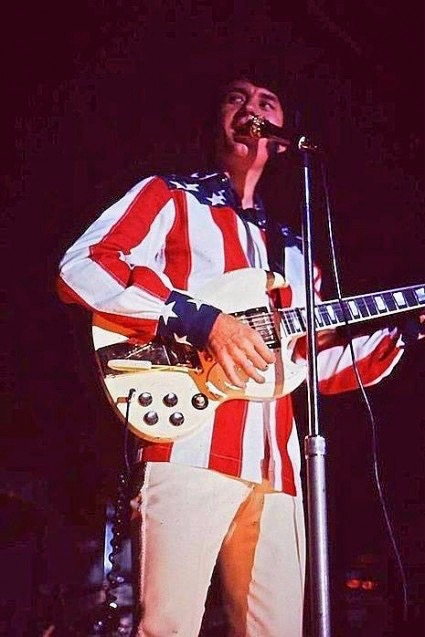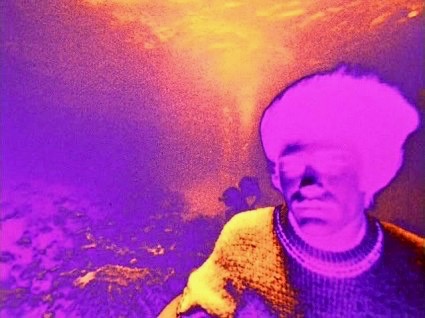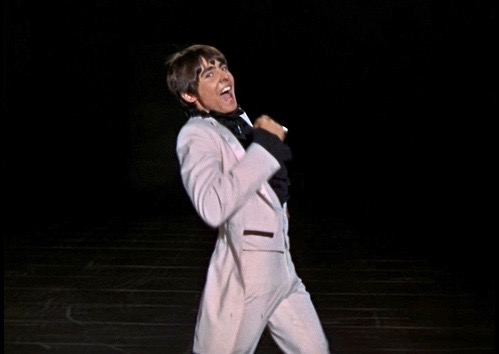It sounds like someone’s LSD flashback. Frank Zappa, boxer Sonny Liston, Annette Funicello, female impersonator T.C. Jones, San Francisco’s legendary topless dancer Carol Doda and other cult celebrities appear in a movie co-scripted by Jack Nicholson and directed by Bob Rafelson (Five Easy Pieces, 1970) that showcases the TV-created pop band The Monkees in the leading roles, who in one scene play dandruff in Victor Mature’s hair. Entitled Head (1968), this Cuisinart-puree of pop culture infused with anti-establishment posturing and served up in the then-current style of a trippy experimental film could only have happened in the late sixties when Hollywood studios were in a try-anything phase to capture the rapidly receding youth market.
Virtually plotless with a free-form structure that owed a lot to the scattershot sketch format of TV’s “Laugh-In” (1968-1973), Head was like the anti-A Hard Day’s Night (1964) for cynical hipsters. Rampant use of recreational drugs among Hollywood’s elite and film industry personnel might have had something to do with it too.
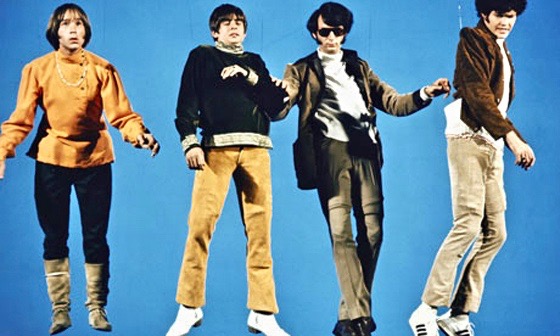
The Monkees reveal the puppeteers behind their strings in the psychedelic fantasy satire Head (1968).
Instead of depicting David, Micky, Michael and Peter as the endearing goofballs worshipped by teenyboppers across America, it deconstructed their image, revealing them to be a synthetic by-product of Hollywood marketing. The irony was that The Monkees were in on the joke and were only too happy to spoof their once popular TV series (1966-1968) and pre-packaged personalities.
Head also marked Bob Rafelson’s feature film debut after an apprenticeship of producing and directing episodes of The Monkees TV series. And it was clearly a transitional film for Jack Nicholson who already had penned several screenplays including The Trip (1967) and was on the verge of stardom without knowing it – Easy Rider (1969), released the following year, would catapult the actor to overnight success. 
Initially called Untitled, Head was an unconventional project from the beginning. According to author Patrick McGilligan in Jack’s Life: A Biography of Jack Nicholson, “Bob, Bert [Schneider, executive producer], and Jack, with the four Monkees in tow, went to Ojai [California] for several days. They smoked “a ton of dope” (as Davy Jones recalls) and tossed ideas into a running tape recorder…The script was set up to have the least continuity imaginable, and only the slenderest plot trigger – the four Monkees leaping off the Golden Gate Bridge in an effort to escape the mental prison of a black box, which was “Head,” meaning pothead, but also meaning all the rules and straitlaced conventions inside one’s head that inhibit enjoyment of life.

A surreal sequence in Head (1968) where Davy Jones battles world heavyweight boxing champion Sonny Liston.
“Everybody agreed that the movie should be anti-Monkees,” according to Patrick McGilligan in Jack’s Life: A Biography of Jack Nicholson. “This creation of Bob and Bert’s had become a Frankenstein monster running amok through their lives. Untitled (as the Monkees film was initially called, as if it were a piece of abstract art destined for museum walls) would expose the very process that had created the Monkees, the hollow, star-making machinery of Hollywood.”

The Monkees (from left to right) Peter Tork, Micky Dolenz, Davy Jones and Michael Nesmith in their first and last feature film, Head (1968).
“The weekend trip did not go without incident,” Micky Dolenz recalled in his autobiography with Mark Bego. “When the time came to discuss writing credit, we were informed that only Jack and Bob would be given credit. We were disappointed and angry. Mike was furious. He took all the tapes and locked them in the trunk of his car! After a few days of “negotiations” the tapes were returned, but we didn’t get any credit!”
Nicholson and Rafelson then went away to the desert for inspiration with their tapes and notes. “Jack and Bob fired up some joints, dropped acid, took a walk on the beach, and came up with the novel idea of deconstructing the Monkees in a melange of music, Vietnam footage, and kitschy pop culture artifacts.” (from Easy Riders, Raging Bulls by Peter Biskind).

Jack Nicholson, Davy Jones and Bob Rafelson are seen during the making of Head (1968), the Monkees’ first and last feature film.
Toby Rafelson, the ex-wife of the director, said “I think that repudiating the very thing the Monkees stood for, using them in order to do this, which he didn’t mind doing, shows you what his colors were, which was that his own image of himself was more important than the product…I think the need to feel cool, in the minds of guys like Bob and Bert, was terribly, terribly important.” (from Easy Riders, Raging Bulls by Peter Biskind).

Former Walt Disney and Beach Party actress Annette Funicello gives fake tears added for a scene in Head (1968), The Monkees’ film debut.
By the time filming began on Head, The Monkees were less than happy with their circumstances. Not only were they feuding with Columbia over their contracts and salaries but they felt betrayed by Rafelson and Nicholson after they were informed that none of them would receive a writing credit on the film.

The Monkees star in their first and only feature film, Head (1968), directed by Bob Rafelson and written by Jack Nicholson & Rafelson & The Monkees (uncredited).
Dolenz later wrote in his autobiography, “Right from the beginning of the television series, there had been a dispute over our salaries…It was Mike, naturally, who took the lead and introduced us to Jerry Perenchio – a very powerful agent in Hollywood at the time. Jerry took us on and promised he would cut us a very lucrative deal. The only problem was that we would have to stick to our guns, make a stand, even strike if it became necessary. It did. I don’t remember what we were asking for, it couldn’t have been much; yet Bob and Bert wouldn’t give in. We didn’t have many choices open to us: either hold firm or cave in. And to make matters worse, Peter had decided that he was not going to join us. Peter! The antiestablishment, anticapitalistic antianti. Here we were, the workers, lined up at the barricades, ready to take on the opulent potentates, and Peter sided with the parsimonious PTB! He was a scab!…The first day of shooting came along and there was only one Monkee on the set: Peter…..But by the next day we were all back. The deal had been done, the negotiations finalized. Unfortunately, even after all the millions that Bob and Bert had made off of the Monkees, I don’t think they ever forgave us for standing up to them that one time.”
Rafelson even began to play records on the set by other rock groups such as The Electric Flag, just to antagonize the Monkees. 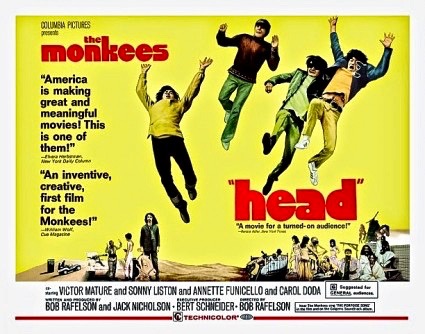
When Head was completed, Rafelson and Nicholson launched a guerilla advertising campaign in New York City, plastering stickers for the film everywhere on taxicabs, signs, police helmets, you name it. At one point they were even arrested for being public nuisances but their efforts were in vain.
The critics were unimpressed and the film held little appeal for anyone who wasn’t a fan of the Monkees’ TV show. Dolenz stated later, “Because the film was rated R, most of our fans couldn’t even get into the theatre to see it in the first place and those who did just didn’t have any idea of what we were up to.” Nicholson, however, maintains even today that Head is one of his proudest accomplishments and still calls it “the best rock-‘n-roll movie ever made.” Despite its commercial failure, Rafelson was equally pleased with it, comparing it often to Fellini’s 8 1/2 (1963).

Micky Dolenz attacks a Coca-Cola machine in the middle of the desert in the absurbist musical comedy Head (1968).
The remarkable thing about Head is how well it holds up today despite being mired in the counterculture of the sixties. Some of the satirical jabs and anti-war rhetoric are as timely as ever, particularly the scene where Micky attacks a defective coke machine in the middle of an Arabian desert set. Or the scene where a deranged football player (Green Bay Packers’ middle linebacker Ray Nitschke) repeatedly tackles Peter in a foxhole while chanting, “We’re number one, we’re number one!”

Micky Dolenz & Teri Garr star in a memorable sequence from the Monkees’ debut film, Head (1968), directed by Bob Rafelson.
My favorite moments in the film feature unexpected cameo appearances from celebrities who have no real connection to the Monkees like 1940s beefcake actor Victor Mature who probably had no awareness of the Monkees until he was cast in the film but he seems amused by the shenanigans….
Or world heavyweight boxing champ Sonny Liston (his boxing scenes with Davy Jones are a distinct WTF moment and particularly brutal for fans of the diminutive singer).
Annette Funicello, who became famous as an actress in Walt Disney productions and later in the AIP Beach Party movies, also pops up as a fantasy love interest for Jones. 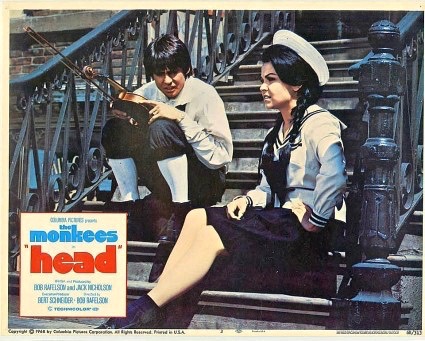
And then there’s the weirdest of all cult actors – Timothy Carey (The World’s Greatest Sinner, Poor White Trash aka Bayou), who seems to get bigger, scarier and more incomprehensible with each recurring appearance. (If you’re a Carey fan and haven’t seen this, you are missing one of his prime showcases).
Rafelson and Nicholson also have fun spoofing different movie genres and in one Western burlesque Teri Garr gets to deliver the immortal line “Suck it, before the venom reaches my heart!” after being bitten by a rattlesnake. The film’s uneasy mixture of comedic throwaway bits with actual newsreel footage of Viet Nam and other flash points of the sixties gives it a subversive edge though some critics found it pretentious. 
“There was this one very disturbing sequence,” Dolenz recalled, “in which Bob used that famous piece of news footage of Vietnamese General Nguyen Ngoc Loan pulling out a snub-nosed .38 and shooting Vietcong Captain Bay Lop in the head….At one point in the movie it is shown thirty-two times simultaneously in split screen.”

The Monkees (from left to right) – Davy Jones, Micky Dolenz, Michael Nesmith and Peter Tork – star in their first and only feature film, Head (1969).
In the end, The Monkees may have had the last laugh since they were finally able to play their own music in Head after being dubbed by studio musicians in their television show (The band members, with the exception of Michael Nesmith, weren’t real musicians when they were first hired for the TV series but learned how to play by the time Head went into production).
And Head includes some of their best songs such as Nesmith’s all-out-rocker “Circle Sky” (recorded before a live audience in Utah), Tork’s two “Summer of Love” ditties, “Can You Dig It” and “Long Title: Do I Have To Do This All Over Again,” “As We Go Along,” a Carole King-Toni Stern composition featuring the guitar work of Ry Cooder and Neil Young, plus “Daddy’s Song” by Harry Nilsson and the psychedelic opening number, “Porpoise Song,” written by Jerry Coffin and Carole King.
Years after being ridiculed as an infantile imitation of The Beatle manufactured for fickle teenagers, The Monkees are finally getting a little overdue respect for Head whose cult continues to grow whenever it is shown. And Bob Rafelson and Jack Nicholson have nothing to be ashamed of either.
Rhino Video released a DVD edition of Head in 1998 but Monkees fans will want to go with the blu-ray or DVD version from The Criterion Collection. The only catch is the film is part of the America Lost and Found: The BBS Story boxed set and is not sold separately. But if you buy that, you also get the other landmark and offbeat BBS films – Easy Rider, Five Easy Pieces, The Last Picture Show, The King of Marvin Gardens, A Safe Place and Drive, He Said. The Head disc includes an audio commentary by The Monkees, screen tests and a rare 1968 TV interview with The Monkees and a lot more.
* This is an expanded and updated version of material that originally appeared on the Turner Classic Movies website. 
And now for some additional Head trivia:
The underwater mermaid sequences were filmed in the Bahamas.
Other locations used in Head included Bronson Canyon in Griffith Park, the Rose Bowl in Pasadena, the Valley Auditorium in Salt Lake City, the Gerald Desmond Bridge in Long Beach and the Screen Gems Studios in Wilmington, North Carolina.
The Monkees’ beach house, which was regularly seen on their TV series, was also used in the film but with some new additions such as an elevator cage and an aquarium.
At the time of filming, Davy Jones was secretly married to Linda Haines but she can be glimpsed briefly in a party scene during the song “Long Title: Do I Have To Do This All Over Again.”
Even though he admitted the screenplay was total nonsense, actor Victor Mature reputedly agreed to do the film saying, “All I know is it makes me laugh.”
Teri Garr was cast in the film because she was a friend of Jack Nicholson. They had taken an acting class together from Eric Morris and some of their classmates were Harry Dean Stanton, Maggie Blye and singer/dancer Toni Basil.

The Monkees rehearse a song while co-screenwriter Jack Nicholson observes during the making of Head (1968).
Helena Kallianiotes, who plays the lesbian hitchhiker Palm Apodaca in Five Easy Pieces (1970), appears as a belly dancer in the “Can You Dig It” musical number.
Director Bob Rafelson worked in New York City as a writer on various television shows before moving to Los Angeles to work on The Monkees as a writer and director. He shared producer duties with Bert Schneider who would later produce Easy Rider (1969) and Rafelson’s Five Easy Pieces (1970).
Rafelson, writer/co-producer Jack Nicholson, and Dennis Hopper make cameo appearances in the Columbia-Screen Gems Studio cafe segment of Head.
Toward the end of The Monkees’ TV series, rock ‘n roll musicians Frank Zappa and Tim Buckley, father of Jeff, made appearances on the show.
Head includes film clips from Gilda (1946), Golden Boy (1939), City for Conquest (1940), The Black Cat (1934), and newsreel footage from the Viet Nam war.
The Coca-Cola company took offense at the scene in which Micky beats up a coke machine in the desert and tried to get an injunction against the movie. They weren’t successful.
The Coca-Cola machine scene is often excised from TV showings of Head. 
Some of the Vietnam war footage that was used in Head was also featured in producer Bert Schneider’s 1974 documentary, Hearts and Minds, directed by Peter Davis. It won the Oscar for the Best Documentary that year.
Carol Doda, who appears in a cameo as Sally Silicon in Head, was a stripper who worked at the Condor Club in San Francisco and expanded her breast size from 34B to 44D through silicon injections.

Michael Nesmith and famous stripper Carol Doda appear in a scene from Head (1968), directed by Bob Rafelson.
T.C. Jones (aka Thomas Craig Jones) was a cross-dresser and eccentric character actor who made memorable appearances in the Jayne Mansfield comedy, Promises! Promises! (1963), the psycho thriller The Name of the Game Is Kill (1968) and such TV series as The Wild, Wild West and The Alfred Hitchcock Hour (the creepy “An Open Window” episode). He plays Mr. AND Mrs. Ace in Head.
The tagline for Head was “What is HEAD all about? Only John Brockman’s shrink knows for sure!” [John Brockman was the mastermind behind the film’s promotional campaign].
The first cut of Head ran almost two hours but after a disastrous sneak preview in Los Angeles it was edited down to a length of eighty-six minutes.
Peter Tork can be heard whistling the chorus to the Beatles song, “Strawberry Fields Forever” in one scene where he enters a bathroom.
Shortly after the completion of Head, Jack Nicholson was cast by Vincente Minnelli in On a Clear Day You Can See Forever (1970) on the basis of his performance in Psych-Out (1968).
According to Micky Dolenz, Frank Zappa once asked him to be the drummer for his band, the Mothers of Invention.
Micky Dolenz described Head in his autobiography as “action, thrills, adventure, sex, horror, slapstick, beautiful scenery, and state-of-the-art visual effects, including, to my knowledge, the first use of “solarization” (that saturated negative colorizing hippie trippie photographic technique). This film was a hippie’s wet dream. Kind of like Hellzapoppin meets Peter Max.”
The composer and conductor of the incidental music cues in Head was Ken Thorne who served as the musical director on Help! (1965), the Beatles’ second film.
Percy Helton, who appears as the Heraldic Messenger in Head, was a prolific character actor who appears in countless films and TV shows such as The Beverly Hillbillies, Green Acres and Bonanza. His film credits include Kiss Me Deadly (1955), 20,000 Leagues Under the Sea (1954) and Miracle on 34th Street (1947) as a drunken Santa Claus.
Head choreographer Toni Basil had a top forty hit in 1982 with the song “Mickey.” You can see her briefly in the “Daddy’s Song” musical number in the Monkees’ film.
Other websites of interest:
https://www.monkeeslivealmanac.com/blog/category/jack%20nicholson
https://variety.com/2018/music/news/monkees-head-50th-anniversary-screening-1203018711/
https://www.theguardian.com/music/2011/apr/28/monkees-head-jack-nicholson-interview






